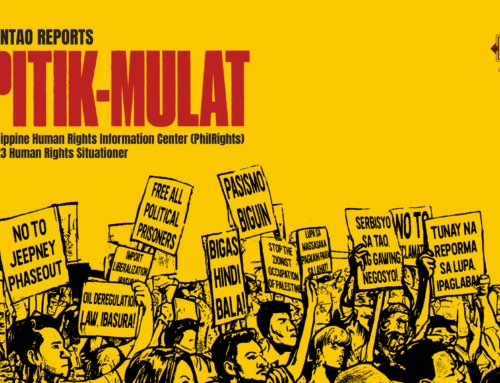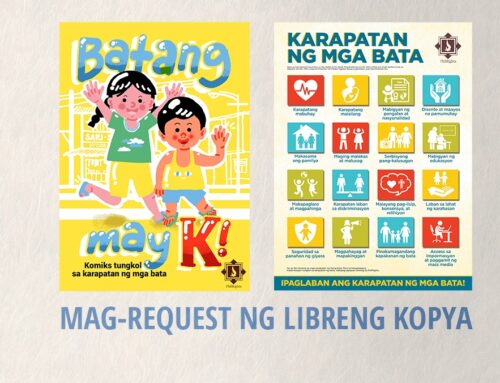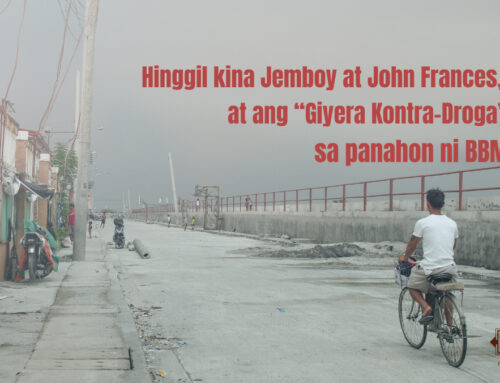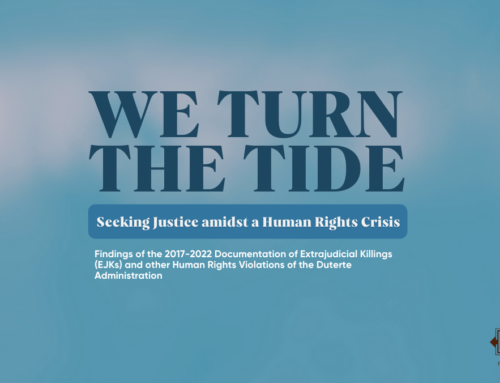Findings of the 2017-2018 Documentation of Extrajudicial Killings (EJK) committed under the so-called War-on-Drugs of the Duterte Administration
by the Philippine Human Rights Information Center
Monitoring and Documentation of EJKs
Since Duterte’s inauguration as the 16th president of the Philippines in 2016, the country has witnessed a steep surge in gross violations of human rights. Extrajudicial killings (EJKs) has become the hallmark of the Duterte administration’s governance.
Along with other human rights organizations, the Philippine Human Rights Information Center (PhilRights) set out to document these cases, primarily to prevent the erasure of these violations from public memory and to assist the victims and their families in various rights-claiming actions that they may want to pursue.
PhilRights’ documentation abides by the principles and investigation guidelines set by The Minnesota Protocol on the Investigation of Potentially Unlawful Death (2016). This document, also known as The Minnesota Protocol, was issued by the Office of the United Nations High Commissioner for Human Rights (OHCHR) to set international legal standards to prevent unlawful deaths and investigate extra-legal, summary, and arbitrary executions.
The Minnesota Protocol clarifies that a “potentially unlawful death” may (1) have been due to the acts of commission and omission of the State, its organs or agents including law enforcers, paramilitary groups, militias or death squads allegedly “acting under the direction or with the permission or acquiescence of the State” such as the infamous Davao Death Squad, and “private military and security forces exercising State functions”, (2) have happened when the victim was in detention by or in custody of the State, its organs or agents, and (3) have been due to the failure of the State to fulfil its obligation in protecting life. Under international law, a “potentially unlawful death” is the product of an arbitrary, summary, or extra-legal execution or an alleged extrajudicial killing (EJK). In the event that the victim survived the incident, the violation is referred to as “frustrated or attempted extrajudicial killing.”
Part I
Findings: The Victims of EJKs
How many were killed?

Demographics
A look at the demographics of 58 victims of alleged EJKs show that victims are mostly male adults within the productive age range, primary breadwinners, low- and irregular-wage earners from the informal sectors of the economy, of low educational attainment, and residents of urban poor communities.
Gender and Age

Occupation

Some of the victims were sleeping in their pedicabs or tricycles when they were killed.
The families of the truck drivers claimed that they were using drugs to help them stay awake during long routes.
The average daily income of 43 of the 52 victims who were earning for their families was Php 301.53, lower than the 2018 minimum wages in Metro Manila (Php 475.00 – Php 512.00), Central Luzon (Php 312.00 – Php 400.00), and CALABARZON (Php 303.00 – Php 400.00), for both agricultural and non-agricultural laborers. There is no information on the income of the remaining nine wage-earner victims. It must be noted that, given the nature of their occupation, their earnings were not regular.
Most of the victims, especially construction workers, carpenters, house painters, porters, and electricians, earn on a seasonal basis. They only had the opportunity to earn an income if they were asked to do specific tasks. Those who were self-employed (vendors, tricycle drivers, scavengers) had fluctuating incomes, usually from 300 to 500 pesos a day, depending on their sales and number of trips made.
On average, each victim had three dependents (this would include children, wife, and elderly parent/s). One victim was supporting 17 people in their household including his children, the children of his siblings, and his unemployed siblings. Nine of them had no dependents but still gave financial support to their families.
Educational Attainment

Place of residence
PhilRights’ documentation focused on the cities of Manila, Caloocan, Malabon, Navotas, Quezon City, and the provinces of Bulacan and Rizal. Most of the documented victims lived in Caloocan (27.59%), Manila (22.41%), and Quezon City (13.79%). These are also the cities with the highest incidents of alleged EJK according to the figures released by the Ateneo Policy Center (APC), based on media/online data they collected (Manila, 23.2% of all media-reported EJKs in the country; Quezon City, 20%; and Caloocan, 18.7%). Outside Metro Manila, Bocaue in Bulacan tops the list in the number of victims documented by PhilRights.

Within the cities and municipalities where PhilRights has been able to document EJK cases from August 15, 2017 to June 30, 2018, there seems to be an uneven distribution of deaths among barangays. Some barangays are notorious for high clustering.
In Caloocan City, the Bagong Silang and Tala registered the highest numbers of documented cases. Bagong Silang or Barangay 176 is the country’s largest barangay in land area and population, covering more than 524 hectares and with a population of more than 245,000 as of the latest census.

Most of Bagong Silang’s residents were ‘relocatees’ from Tondo in Manila, Commonwealth Avenue in Quezon City, and the city of San Juan. On the other hand, Tala covers five barangays with a total population of more than 12,000 (2015 census). Nine alleged EJK victims were documented in Bagong Silang; three in Tala. Most of them were migrants from other cities. The remaining victims in Caloocan City were from Camarin (2), Bagong Barrio (1), and Heroes del 96 (1).
In the city of Manila, nine of the documented 13 victims lived in Tondo: three of whom were from Parola, an informal settlement near the estuary of Pasig River; two lived in a tenement house in northern Tondo; two were brothers living in a small house along Euseco Street; one lived on a footbridge in Delpan; and one in an informal settlement in Barangay 19. These are some of the most impoverished areas of the city. The rest of the EJK victims in Manila were residents of Balic-Balic in the district of Sampaloc near Quezon City, where more than 25 alleged EJK cases have already been reported.
In Quezon City, five of the 19 documented victims were from Brgy. Payatas, a barangay north of Tullahan River where a number of informal settlements can be found. PhilRights also documented alleged EJK victims in Old Balara (1) and Holy Spirit (1). A victim of frustrated EJK is also from Quezon City.
The relocation areas of Brgy. Batia in Bocaue, Bulacan are the hotspots of killings in the municipality (six documented victims). Another EJK case was documented in Brgy. Wakas.
Four of the five documented victims in Navotas City were from the relocation site on the reclaimed parts of Barangay Tanza, now known as Tanza 2. One was from Brgy. North Bay Boulevard South (NBBS), now known as NBBS Dagat-dagatan.
In Malabon City, all of the documented victims lived in Brgy. Catmon, one of the most impoverished barangays in the city.
Brgy. Gaya-Gaya, where all of the documented victims in San Jose del Monte City, Bulacan resided, is another EJK hotspot. A large portion of the barangay is home to ‘relocatees’ from Navotas City. The families of the documented victims are still tied to the fishing industry in Navotas City, causing them to travel far southwest on a daily basis for their livelihood.
Modalities and Patterns
Aside from knowing who the victims are, what they do for a living, and where they come from, this analysis also seeks to reveal some of the most striking patterns and modalities of violations, as mined from the details of the incidents. This is to show when and where they usually happen, who the perpetrators are, the common narratives propagated by the official reports, the usual methods of killing, the other violations committed before, during, and after the killing, and other factors that compound the suffering experienced by the families of victims.
One of the trademarks of the ‘war on drugs’ is the release of drug watch lists. These are lists of names of individuals alleged to be involved in the drug trade. In February 2018 for example, the Philippine National Police (PNP) released 11,000 names which, according to them, was validated by the agency’s Directorate for Intelligence (DI). These watch lists are questionable because the methods in coming up with the lists have been arbitrary, not evidence-based, and at times, dictated by the whims or caprices of authorities at the local level. Armed with these dubious lists, police authorities then visit those in the watch list to convince them to stop their drug use or involvement in the drug trade and to surrender to the authorities. According to the Ateneo Policy Center, 22.9% of the EJK cases reported online involved persons who were also known to be in the local watch lists.

The informants for 11 of the victims said that they personally saw the watchlists; the rest were informed by their neighbors and friends who said that they saw the watch list. Four of the victims were visited by police authorities; of these four, three surrendered to the police and underwent some form of rehabilitation programs and activities such as street sweeping
When were they killed?


Twenty one (36.21%) of the victims were with other people (other family members, relatives, friends), engaged in mundane activities (watching television, having conversation) when the perpetrators came to kill them. Ten (17.24%) were asleep in their respective homes or in their pedicabs. Five (8.62%) of the victims were working when they were killed. There is no information on the activities of seven victims (12.07%) due to the absence of witnesses and the lack of knowledge of the informant.
Distribution of documented killings by city and municipality

In Rizal, the lone documented victim was killed in Cainta which is a town adjacent to his hometown of Taytay. A victim from Navotas City died while in the custody of Malabon police.
Similar to the geographic clustering of the victims’ place of residence, most of the acts of killing were perpetrated in impoverished areas such as the informal settlements of Tondo, Rizal and Catmon, Malabon, relocation sites of Gaya-Gaya, San Jose del Monte City, Tanza, Navotas City, and Batia, Bocaue City. In Caloocan City, Bagong Silang and Tala are the red zones for killings.
Aside from the prevalent poverty and lack of livelihood opportunities, these communities are likewise identified by authorities as hotspots of drug abuse, drug trade and petty crimes. It is easier for police authorities to conduct their operations without any objection from the stakeholders of the community.
Location of killing

Subdivisions and gated communities, on the other hand, are more difficult to penetrate due to the physical barrier and the steps that the police have to undertake in order to avoid violating the residents’ rights and privileges.
Context of killing
Police operations and under police custody – Police operations, including serving of warrants and sweep searches, constitute lethal and non-lethal activities of police forces. Under PhilRights’ documentation, alleged EJKs are categorized as ‘having occurred during police operations’ if:
a) Police authorities, whether in official uniform or not, introduce themselves as such during the course of the operation
b) The police authorities acknowledge (to the media or in official records) that the incident was a police operation
Incidents involving such directly allege the police officers who conducted the operations as the perpetrators. Interestingly, there are contradictions between what the police reports state and what the families say about the conduct of the operations. For example, a case may be reported as a buy-bust operation while the family would assert that the police entered their house without any warrant or sufficient acceptable cause except to kill their target.
Operations believed to be conducted by the police as alleged by our informants – Apart from police operations, many killings were also committed under operations by unidentifiable perpetrators believed to be police officers as alleged by the informants. The informants, being the witnesses themselves, claim that the perpetrators are police officers based on their physical attributes and on the witnesses/informants’ familiarity with police authorities operating within their communities.
Operations conducted by unidentifiable assailants and riding-in-tandems assassins – Another group of perpetrators involves vigilantes and killers riding in tandem. The perpetrators of these cases are usually masked and dressed in black or dark-colored clothing. There are also non-police perpetrators who wear civilian clothes and/or do not hide their faces. The alarming surge in the occurrence of such operations, especially those that have been conducted against those suspected of involvement in drugs, has led most informants to conclude that these unidentifiable killers could be working under the auspices of the government.
Operations conducted by barangay officials and personnel – A fourth group of perpetrators include barangay officials, staff, and personnel.

Number of documented victims by type of operation

Caloocan City police officers (9) committed most of the documented lethal police operations, followed by City of Manila (6) and Quezon City (5), accounting for 76.92% of all the documented killings.
The two barangay personnel alleged to be perpetrators both work for Barangay Tanza local government unit in Navotas City.
Riding-in-tandem assailants comprise 43.33% of the documented unidentifiable perpetrators, most of whom conducted their operation in Caloocan City (5) and City of Manila (5). The other sub-category of unidentifiable assailants are those masked killers who usually break into the victim’s house to perpetrate the killling. They comprise 56.67% of all the documented unidentifiable perpetrators, with victims from Bocaue, Caloocan City, City of Manila, Navotas City, and Quezon City.

Manner of killing

One victim had 16 gunshot wounds; he died in an operation that informants allege was conducted by Caloocan police officers.
The purpose of using a median figure in this analysis is to set a data-based numerical boundary from which overkilling, attempted or not, can be deduced. One can argue that the use of more than one bullet to stop the target from running away or from fighting with the arresting police officers is already enough to identify signs of undue force. The use of excessive force is not allowed as stipulated in Rule 7 (Use of Force during Police Operations) of the Revised Philippine National Police Operational Procedures unless it is reasonable to do so given the number of aggressors, nature and characteristic of the weapon used, physical condition, size and other circumstances to include the place and location of the assault. Based on the narratives of the informants, none of the cases satisfied the need to use excessive force.
Gunshot wounds
The figure shows that the 19 (32.76%) of the victims sustained chest wounds. Seventeen (29.31%) had gunshot wounds in the abdominopelvic region.

Other HRVs prior to killing
Some of the documented victims had experienced other human rights violations before the killing. Three of them had been arrested and detained illegally; one of them was killed the same day after his release and one was detained one month prior to his killing. The remaining victim was allegedly killed while in detention. Another ten victims had suffered from torture before being killed, as evidenced by the bruises and marks all over their body and head.

The families who witnessed these violations also experienced some forms of violations. Two common-law wives and one daughter were illegally arrested and detained after the victims were killed during police operations.
To justify the use of excessive force and that killing was indeed necessary, authorities are purveying the “self-defense” or nanlaban narrative: that the victim initiated the gun fight with the police officers, and the latter were forced to defend themselves. However, the saturation of the self-defense or nanlaban argument in media and police reports has prompted people to question their claims.
Seventeen victims allegedly engaged in gunfight with the police officers during police operations. The police reports, which were the main documentary sources of the media for their news reports, state that the victims fired first. The informants, however, assert that these reports are without basis.
The official narrative is that the victims (1) were involved in illegal drugs and (2) engaged authorities in a shootout. Guns, usually found on the victims’ hands, are used as evidence to show that they attacked or fought back. The presence of drugs on the site is used to link the victims to the drug trade.

Most of the informants assert that the evidence found on the sites of killing did not belong to the victims, saying that they were too poor to afford guns and drugs. For the police operations and some of the operations believed to be conducted by police officers and by unidentifiable assailants, the informants claimed that the victims were framed and that these pieces of evidence were planted by the perpetrators.

Another modality revealed from the data is the killing of the wrong person either because of mistaken identity or the practice of ‘palit-ulo’ whereby the victim has been substituted for another target just so the alleged quota requirement could be fulfilled. Four of the documented victims fall under palit-ulo; one of them died in a police operation.
Some of the death certificates do not state the true cause of death of the victims. One documented victim killed in an operation believed to be conducted by police officers had “pneumonia” as cause of death; another victim killed by unidentifiable assailants had “cardiac arrest.” Falsifying the death certificate is one way by which EJKs are being erased from official records. It makes it easier to deny that extrajudicial killings are being perpetrated.
The surge in killings has been generally beneficial for funeral parlors, especially those that are accredited by the PNP Crime Laboratory. The families of the victims have the right to retrieve the bodies at reasonable costs should they wish to transfer the bodies to their preferred funeral parlors. However, there have been documented cases involving families being forced to pay exorbitant fees from Php 25,000 to Php 50,000 for services, including embalming and autopsies, whether or not these services have been performed.
Part II
Life after Death: The Impact of EJKs to the Families Left Behind

As established in the first part of this report, this study’s documented victims and their families already suffered from impoverished conditions prior to the victims’ deaths. Most of the victims belonged to an extended household and have carried the burden of intergenerational, multi-faceted problems rooted in their disempowered state and lack of opportunities for economic and social growth.
However, it must be emphasized that an EJK death does not end the human rights violation. In fact, it is an inciting incident to a host of interrelated negative conditions that have gravely undermined the economic and social rights of the families left behind.
While there have been various attempts to verify the number of killings and their patterns and modalities (presented in the first part of this report), there is still no comprehensive examination of the impact of an extrajudicial killing to the families left behind. This report, a summary of interviews and engagements with the victims’ families conducted over a period of one year, reveals the many ways in which the so-called war on drugs has set in motion widespread suffering and human rights violations. The names mentioned in this report are aliases to ensure their anonymity and safety.
Immediate Effects to the Family
Mrs. Rodriguez earns money by manually cutting up rubber slippers. After meeting her daily quota around midnight, she asked her son to buy her food. She fell asleep, waiting for the son that never returned. What neither mother nor son realized was that this would be the last time they would see each other.
In the early morning, Mrs. Rodriguez ventured outside and met a neighbor who told her that the police took her son along with a few others during an anti-tambay operation. She looked for him in the police station, in nearby hospitals, and in the barangay hall to no avail. A security guard in a nearby hospital then shared that he saw a young man fitting her son’s description. This young man was brought to the hospital by a police patrol, the security guard said. He told her to look for her son in a funeral parlor known to take in the remains of those killed in police operations.
There, after 14 hours of frantic search, she found her son, lying on the morgue, lifeless.
Mrs. Rodriguez’s story stands alongside many others: of elderly mothers and widows who took on the task of searching for their missing sons and husbands. These men, victims of the bloodbath of the anti-illegal drugs campaign, are found cold and lifeless, if not immediately on the streets where they were killed, in dumping grounds of human bodies and in the morgues of funeral parlors dotting urban poor communities. The women stay alive, but their tragedy has only begun.

Even when their loved ones’ bodies are found, the women must immediately deal with the high costs of funeral and burial services. In the midst of their grief, they become susceptible to overpriced services if not direct harassment from unscrupulous funeral parlors who have found lucrative business in the deaths arising from President Duterte’s so-called war on drugs.
Mrs. Rodriguez, whose earnings are way below the minimum wage, has no means to afford the Php 50,000 fee of the funeral parlor. Her one recourse is the abuloy—small monetary offerings of visitors to her son’s wake. Alas, nightly police presence, indeed harassment, according to the family, has discouraged neighbors and relatives from coming into their tiny home to pay their respects. Mrs. Rodriguez’s only choice is to stretch the wake’s schedule until they can scrounge up enough money to meet the demands of the funeral parlor. Almost four weeks into the wake, and after much begging by Mrs. Rodriguez and her family, the funeral parlor agreed to complete the service despite not having paid for all their demands. On the day of burial, the funeral parlor did not show up, and in fact refused to send out their funeral hearse, insisting that the family comply with all their financial obligations.
This was an appalling indignity by any measure. But Mrs. Rodriguez, who was initially reluctant to seek justice, has found the strength she needs to demand accountability for her son’s death.

Livelihood and Income of the Family
Of the 58 documented cases of extrajudicial killings, 49 of them were the primary financial providers of the family. Ninety-five percent of these primary financial providers were male individuals supporting their elderly parents, wives and children, siblings, and in some cases, their nieces and nephews. After their deaths, the burden of taking up the income-producing role fell to their widows and elderly mothers.
At least half of the widows and elderly women left behind resorted to unregulated below-minimum wage employment such as working in canteens and doing laundry. A few, however, have resorted to sex work, according to their family members.
These limited employment opportunities are typically due to the women’s low educational background and lack of work experience as most them were limited and restricted to household chores before the death of the male financial provider.
Those who became helpers would work for almost 12 hours, earning an average of 150 pesos per workday. Meanwhile, most of the elderly women who resorted to accepting laundry work showed a decline in physical well-being that further affected their capability to take on the work.
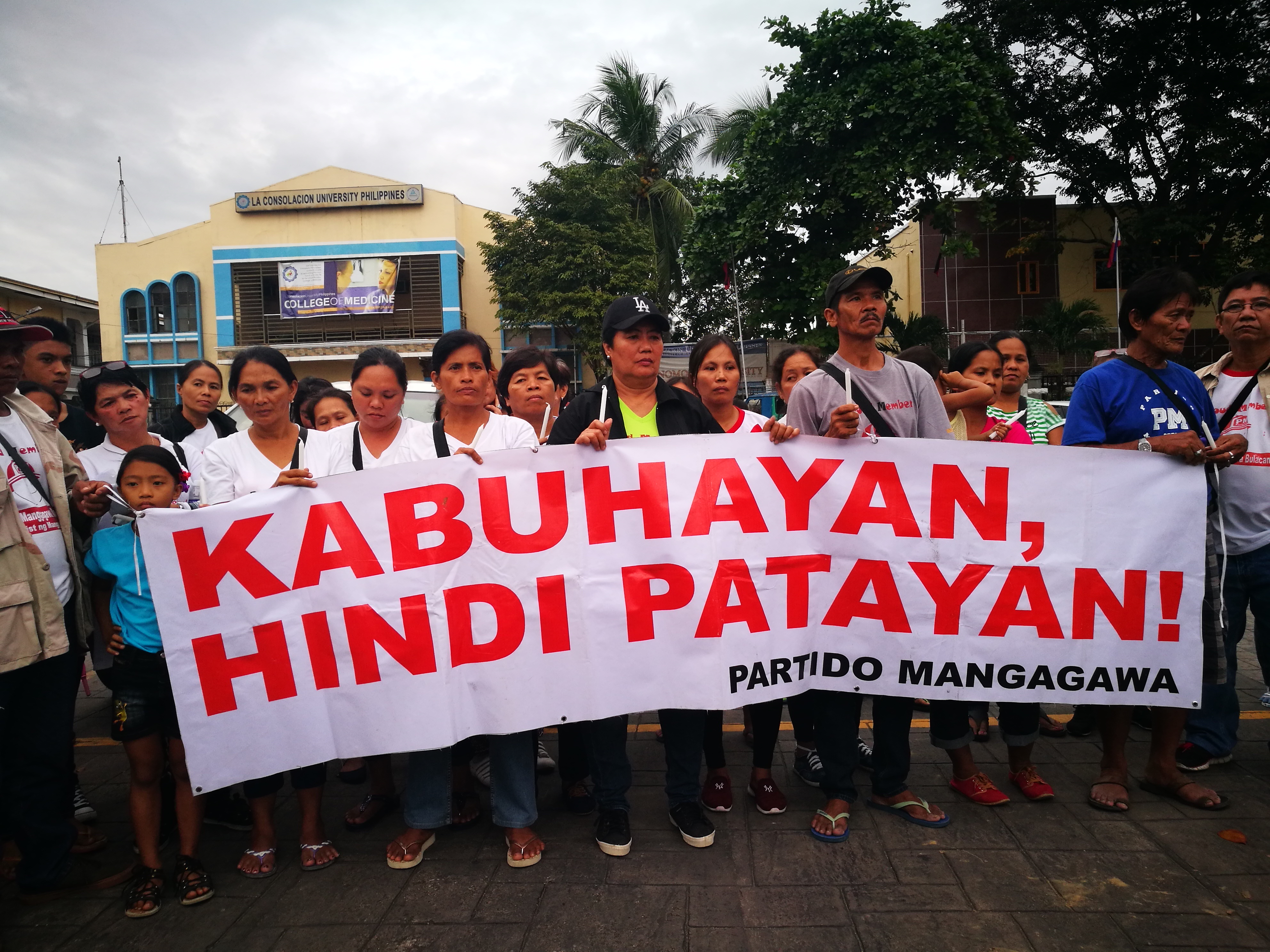
Although there are government programs and services aimed at providing financial assistance and livelihood for poor families, the application process is difficult for mothers like Sarah. She has four children, aged 4 to 13 years old. Since her husband’s death, she has worked as a canteen help every day of the week, earning Php 200 a day which is spent for their daily expenses. Given her low wage, Sarah cannot spare a working day to line up and process her documents to qualify for government aid.
The problem of access to government assistance for new breadwinners like Sarah has further declined their ability to augment their family’s economic needs and has restricted them from providing a sufficient standard of living for themselves and their dependents.
Given these hindering factors, new breadwinners like Sarah have to face the long-term challenge of earning while providing care for their young children.
Education of the Children

Access to education for children from grade school to college is already difficult for most of these families; an EJK-related death further exacerbates their struggle. For children who are able to continue their studies, many have begun to experience bullying within the school because of the stigma attached to the death of their family member.
Anna Marie, a 12-year-old Grade 7 student, lost her father during a police operation in their barangay. The child had already been dealing with the loss of a father figure from her parents’ separation. Her father’s violent death intensified her feelings of loss. According to her mother, Anna Marie and her siblings enjoyed a good relationship with their father despite their problems as a couple. Even when the parents separated, the father visited the children and spent time to bond with them.
After her father’s death, Anna Marie’ s mother started receiving frequent school calls because the child’s teachers observed disturbing behavior from the child. Her classmates were aware of the case of her father which made it even more difficult for Anna Marie to adjust. She began showing aggressive behavior towards her classmates which her mother believes is her daughter’s way of coping.
Anna Marie’s mother is very concerned because her child’s behavior is affecting her school performance, something which has not been a problem before the death of her father.
Another case is that of Roman, a nine-year-old boy who lost both of his parents from a police operation. His 62-year-old aunt now has custody of Roman. The aunt, who also has children and grandchildren of her own, has no stable means of income. The child almost had to quit schooling because of lack of financial means.
Anne Marie and Roman are but two of the many children whose education are now suffering because of the sudden loss of financial support, of bullying and harassment in school, and of trauma.
Shelter, Safety, and Security

With unsafe streets, the only remaining bastion of security is the family home. Unfortunately, this is not the case for the 27 families whose family members were shot dead inside their homes. For these families, their homes have also become a site of horror and tragedy, serving as a daily reminder of the loss they experienced. Outside, many of the family members attested that they still constantly hear about or even witness masked men entering their neighborhood. The sight of police and their activities, to them, now represent death rather than security.
Allelie, now a single mother to two young boys, reported a frightening encounter concerning her children. An unidentified person, pretending to be a relative, attempted to fetch her two sons from school. Out of fear, Allelie decided to relocate to another community where no one knows the family story and where she believes they will be safer. Despite relocation costs adding to the burden for the new breadwinner, Allelie sought to move as soon as she could.
While most of the families remained in their homes—despite their lingering fears—four families chose to relocate to the provinces or other cities for fear of the perpetrators coming back to attack them.
Health of the Family
The families’ health, especially that of the elderly and children—already compromised because of their economically disadvantaged positions—saw pronounced declines following the death of their family members.
The killing of Angel Roa—he was among the 27 documented individuals in this study who was killed inside their home—led to many health problems for his mother. During the wake, Mrs. Roa refused to sleep and eat. She also developed an infection in one of her eyelids that turned into a cyst. It was also discovered that she had a lung condition which meant that she had to be confined in the hospital frequently. The Roa Family attributes these health issues to Mrs. Roa’s grief. A year and half after her son’s death, Mrs. Roa also passed away.
Juan, one of the few who survived the attempted extrajudicial killing, sought and was given protective custody by the Commission on Human Rights (CHR). During this period, his elementary-age children was left with his infirm parents whom have no means of subsistence. In his absence, his parents and children had to adjust; for instance, skipping meals because they can only afford one kilo of rice per day.
Having been the primary breadwinner and feeling guilty that his elderly parents and children are enduring daily hunger, he requested to leave CHR’s custody.
The inability to meet the families’ nutritional needs is one of the leading cause why health problems occur among families like that of Juan and Angel Roa. The loss of a breadwinner greatly affects the already poor health conditions of the family.
Psychosocial Effects on Children, Spouse and Other Family Members
Coping is a long process of grief, anger, and acceptance, especially in instances of violent and sudden deaths of family members. The killing of a family member is a triggering event that caused a shift in the families’ functioning as a unit and as individuals. Not only do they suffer from the loss of a loved one; they also have to endure the disempowering stigma of having a drug-related killing marked against their family.
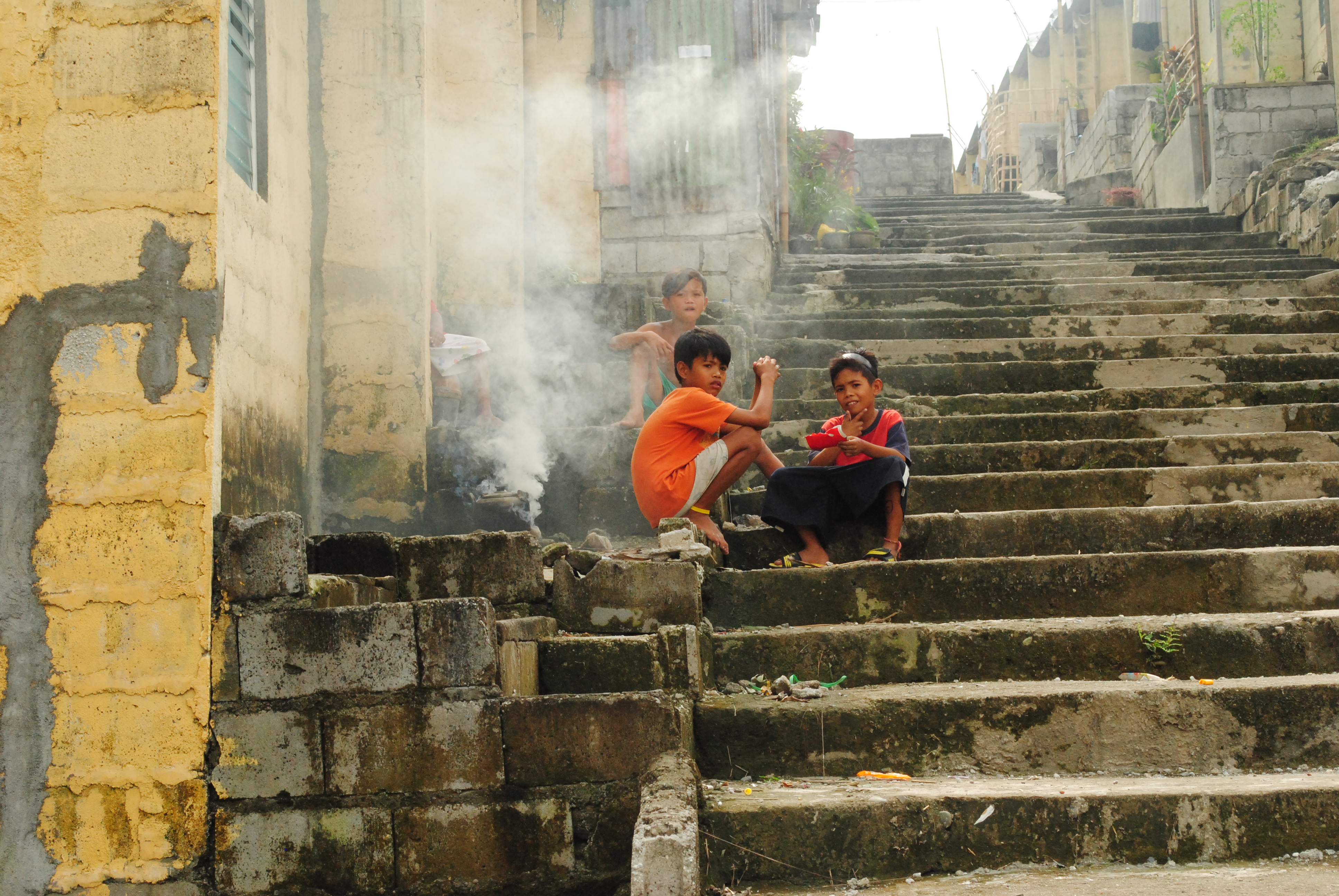
Children
The death of a parent, a sibling, or any member of the family is an already difficult situation for any child to process and often affects the child’s growth and development, but the effects are markedly worse when the family member was killed in relation to the government’s so-called war on drugs.
The prevalence of violence, the concept of revenge, and the culture of fear that envelops their daily lives all have direct effects on the developmental stages of children. These then affect the formation of their values and principles as young human beings. As children experience first-hand the loss of a parent, a sibling, or a close relative, they present changes in their temperaments and behaviors.
Every widowed mother interviewed by the PhilRights team acknowledged significant changes in their children’s behavior: Some have become verbally and physically aggressive, with short tempers even during play time. Children as young as four years old suddenly preferred staying out in the streets with their peers instead of at home where they might be reminded of their fathers’ loss.
The mothers acknowledge their children’s need for therapy and counseling. However, they are not fully aware how to access such services for their children. In fact, out of the 72 orphaned children identified in this study, only 12 children were able to access some form of psychosocial services.
Spouse
As mentioned in the first part of this report, most of the spouses left behind are the wives, who then had to take on the additional role of a father figure just to maintain the balance in the household. Aside from their original roles as homemaker, mother, and community member, they also have had to transition towards becoming the breadwinner of the family. This also meant that they have had to put their grief aside and put up a strong front in order to make a living and support their children.
Three widows from the same community with children as young as four years old and as old as 12 met through an initiative of their parish to bring together widows and elderly mothers whose sons have also died due to extrajudicial killings. The group, loosely formed, became a support system; the three widows have said that they found strength in their common experience which has allowed them to carry on with their day-to-day homelife situations. Yet their losses have not been fully processed and they still experience days where they still feel the pain of losing a helpmate. Because of their multiple roles in their families, they can only acknowledge their need for psychosocial help without actually seeking it.
As of this report’s writing, only four widows have accessed some form of psychosocial services.
Other Family Members
Parents and siblings suffer as much loss as the wives and children of the victims. Filipino families have close ties and these are particularly stronger among urban poor families who have inextricable emotional and socioeconomic links among their members. In the 58 documented cases, all families exhibited close family ties, with several victims and their families who lived within a compound with either spouse’s parents. The deaths, therefore, caused profound sorrow for their parents, siblings and extended family members.

Deprivation of Right to Family among Orphaned Children
Hayden, a 17-year-old Senior High School student, died when his similarly aged partner was just a few months away from giving birth. Hayden, according to the family, was killed instead of the real target because the police were not able to catch the alleged drug pusher. According to his partner, Hayden had many plans for their newly formed family. Having grown up without a biological father, Hayden vowed to his partner that this would never happen to their child.
Not only did Hayden lose his chance to be a father to this child, the child also lost the chance to be cared for by his father. Hayden’s partner is now a widowed teenage mother.
In our identified cases, 72 children now have to endure the loss of a parent.

Effects to the Community
Extrajudicial killings have resulted in changes in neighborhood dynamics, marked by distrust and distance. In a few areas, the opposite has also occurred, with community support galvanizing around families of the slain. (But this has only come about because of a strong and sustained support system from the Church and other civil society organizations.) The families that remained in their neighborhoods described their neighbors becoming distant and unapproachable. Although there were no particular threats or attacks from the neighbors, the families felt that besides losing a family member they also lost the immediate support system that is their neighborhood.
Less common, but still important to highlight is the case of The Most Holy Trinity Parish in the community of Balic-Balic, Sampaloc, Manila. The parish formed a Human Rights Ministry that offered a safe space for families of victims of extrajudicial killings in the area. This initiative enabled the families to provide support for each other and develop bonds out of their shared experiences.

Photos by Mateo P. Garcia, Eugene Geras, and Pepito Frias





